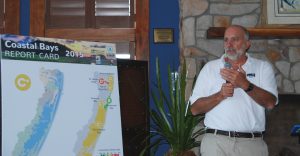
OCEAN CITY – The Maryland Coastal Bays Program gave area waterways a C-plus for 2015 in its annual report card, unveiled at the Ocean City Marlin Club on Sept. 8.
Since its last report, the Coastal Bays Program has seen phosphorous levels rise and seagrass levels fall, according to Maryland Department of Natural Resources Environmental Program Manager Cathy Wazniak.
Although seagrass levels have decreased, Wazniak says conditions could improve as the water quality increases.
Populations among living resources, such as crabs and clams, have maintained and improved along most waterways, Wazniak says. But scallops have not returned to Chincoteague Bay since 2005, despite improvements in water nutrient levels.
Maryland coastal bays are graded based on reports from six regions: Assawoman, Chincoteague, Isle of Wight, Newport, and Sinepuxent Bays and St. Martin River.
Health conditions deteriorated in Sinepuxent and Chincoteague Bays, but improved in Assawoman and Newport Bays, Wazniak says.
Isle of Wight Bay and St. Martin River saw no change.
Overall, the program gave Sinepuxent and Chincoteague Bays the best health scores and St. Martin River the worst.
The rating is based off chlorophyll, dissolved oxygen, nitrogen, phosphorous, seagrass and hard clam measurements taken from all six waterways.
These measurements are then averaged out to reflect the overall quality of the coastal bay region.
This year, the coastal bay system received a score of 57.9 percent, two percentage points less than last year’s score.
Yet, these numbers have improved since 1996, when the coastal bays received its lowest overall health score of 11 percent.
Maryland Department of Natural Resources’ Senior Bay Restoration Coordinator David Goshorn says the first one or two years of monitoring are expensive and yield useless and incomparable results. Yet over the years, consistent data has since helped monitor and preserve the bays.
“These monitor programs may not always tell us what we want to hear, but they tell us the truth,” Goshorn, says. “And knowing the truth of what can be better or worse is the only way to have hope whatsoever.”
Dr. Bill Dennison, professor at University of Maryland Coastal Center for Environmental Science, says the waterways still have to improve, but applauds the bays’ stable conditions.
“Getting a C-plus in spite of development, or population growth and intensified use, is an accomplishment,” Dennison says. “Not to rest on our laurels, we still have a long way to go.”
Dennison says he hopes next year’s health report card will improve to a B-minus.
Officials from the bays program, and their partners at the University of Maryland, the state DNR, the National Park Service and the Environmental Protection Agency, will take this data and use it to further improve the coastal bay system through various management plans, according to the program’s Science Coordinator Roman Jesien.
“We are looking to upcoming events and how we will be progressing in our restoration efforts,” Jesien says.
Although it is not clear how the program and its partners will pay for these improvements, Jesien says the answers will come with time.
In the past year, the program had 400 volunteers who spent 1,500 hours in the bays, according to program Director Frank Piorko.
“This is a team effort in everything we do,” Piorko says. “Another C plus doesn’t sound like news, but we’ve looked more specifically at each bay watershed and understand the relevant trends to know our management strategies need to be adjusted.”
A detailed report on the coastal bays’ health from every year can be found at www.ecoreportcard.org.

